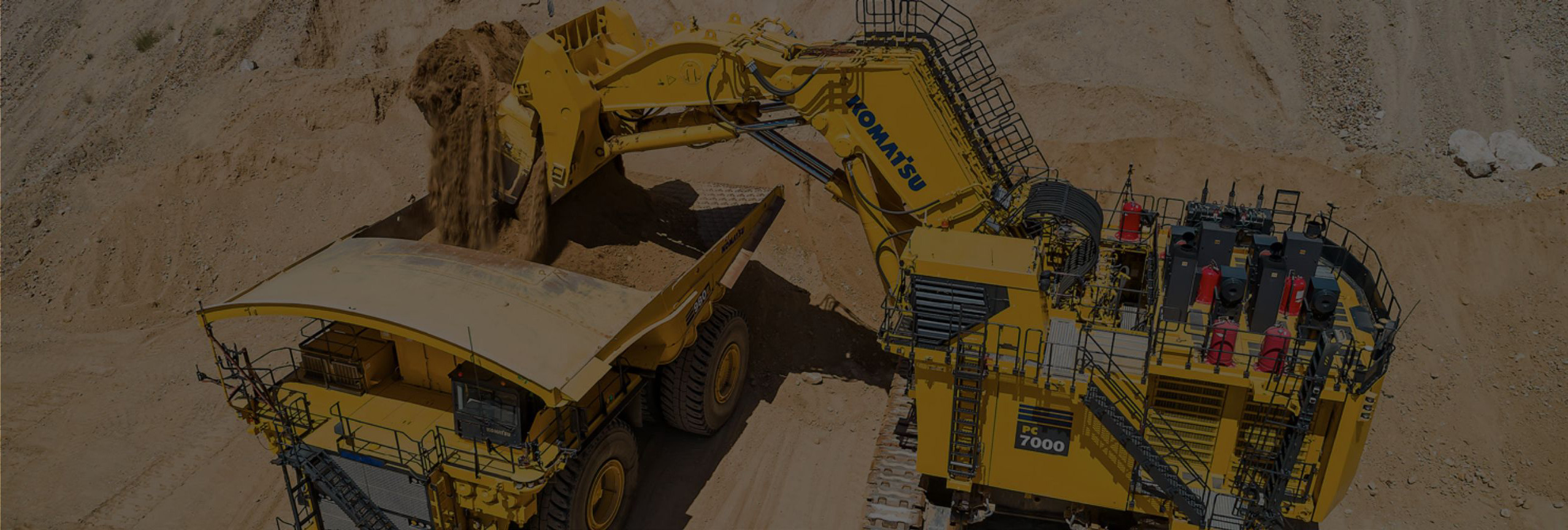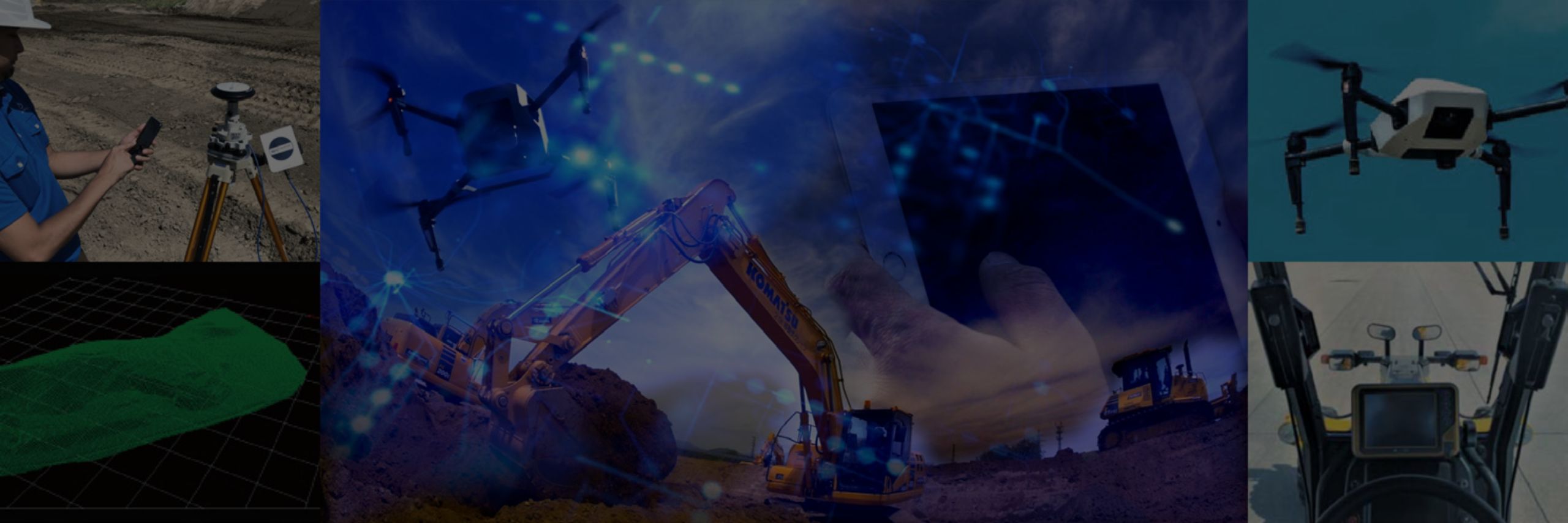

Creating new customer value by solutions that optimize customer’ entire operation processes, the products that are highly compatible with those solutions are essential.
We succeeded in the world’s first commercial deployment of Autonomous Haulage System (AHS) in 2008 and launched the world’s first ICT-intensive equipment in 2013. Komatsu’s automation development efforts of construction and mining equipment are steadily marching toward the next stage in pursuit of further enhancement of customers’ job site safety and productivity.
We are rapidly approaching the job sites of the future, where one might see a hydraulic excavator operated from an office hundreds of kilometers away excavating and loading earth and sand into an autonomous dump truck as if it is being operated by a skilled operator.
Creating new customer value by solutions that optimize customer’ entire operation processes, the products that are highly compatible with those solutions are essential.
We succeeded in the world’s first commercial deployment of Autonomous Haulage System (AHS) in 2008 and launched the world’s first ICT-intensive equipment in 2013. Komatsu’s automation development efforts of construction and mining equipment are steadily marching toward the next stage in pursuit of further enhancement of customers’ job site safety and productivity.
We are rapidly approaching the job sites of the future, where one might see a hydraulic excavator operated from an office hundreds of kilometers away excavating and loading earth and sand into an autonomous dump truck as if it is being operated by a skilled operator.

In ultra-class dump trucks for mining, unmanned trucks with high-precision GPS and obstacle detection sensors are controlled remotely form the central control room. In addition, we have finished development of remote control models of a hydraulic excavator with automatic bucket control functions and a bulldozer with automatic blade control functions. These are just some of the milestones on the path toward higher levels of automation and autonomy in equipment.
By deploying its automation technologies to various models of various classes of equipment, we will expand our lineup of automated construction and mining equipment, contributing to improvements in workplace safety and productivity.

We have jointly developed a remote control system for construction equipment and begun offering it to customers with EARTHBRAIN
in March 2023.
Going forward, we are working to combine this remote control system with the automatic control technologies accumulated over the years via the development of ICT-intensive bulldozers and hydraulic excavators. Through this merging technologies, we are going to help customers improve the safety and productivity of their workplaces.

Recent efforts to expand our lineup of AHS products have been the development of an autonomous water truck based on AHS. We have also launched of a joint project with Toyota Motor Corporation to develop an Autonomous Light Vehicle (ALV).
In addition to AHS-equipped dump trucks, we are also advancing a number of other initiatives to improve safety and productivity across the mining operation. Examples of these initiatives include development of ultra-class hydraulic excavator, PC7000-11 teleoperation model and the commercial operation of large-scale ICT bulldozers for mining, D375Ai/475Ai-8 teleoperation model.


To achieve carbon neutrality by 2050, we are advancing various initiatives, especially in the area of electrification of construction equipment.
In addition to conventional efforts for reducing CO2 emissions from products due to optimal combination of components developed and produced in-house, we are striving to focus on development new products and technologies by expanding our partnerships.
“Providing many options developed to meet the unique requirements of a diversity of customers’ environmental needs.”
We have positioned FY2023 as the first year for the market introduction of electric construction equipment, and we are steadily working to create a market for the impending era of electrification.
To achieve carbon neutrality by 2050, we are advancing various initiatives, especially in the area of electrification of construction equipment.
In addition to conventional efforts for reducing CO2 emissions from products due to optimal combination of components developed and produced in-house, we are striving to focus on development new products and technologies by expanding our partnerships.
“Providing many options developed to meet the unique requirements of a diversity of customers’ environmental needs.”
We have positioned FY2023 as the first year for the market introduction of electric construction equipment, and we are steadily working to create a market for the impending era of electrification.


*Komatsu Hydraulic Mechanical Transmission (KHMT): A transmission that combines a variable-speed, hydrostatic transmission (HST) which uses a variable displacement hydraulic pump and motor, with highly efficient mechanical transmission. It delivers a 30% improvement in fuel efficiency compared to conventional models.
Roughly 90% of Komatsu’s CO2 emissions are attributable to product in use. We have therefore been making efforts to reduce CO2 emissions from product use through the development of highly fuel-efficient products, including hybrid hydraulic excavators. With the goal of achieving even greater reductions in emissions, we are now developing construction and mining equipment that uses batteries and other new power sources. The customer needs for products with regard to output and operating time vary based on the size and application. To address these varied customer needs, we are advancing phased R&D approach of equipment models that use new power sources such as batteries, fuel cells, and hydrogen engines.





Smart Construction was embarked for addressing various issues surrounding the construction industry in Japan such as serious labor shortages with digital technologies.
Smart Construction has been improving operation efficiency on customers’ sites through the combination of 3D data surveyed and generated by drones and other IoT devices and applications with high-quality operations performed by ICT-intensive
construction equipment. This solution is now evolving into DX Smart Construction that organically connects customers' entire operation processes to achieve further improvements in customers' productivity.
We are globally expanding DX Smart Construction in order to resolve our customers’ issues with a sophisticated combination of solutions that optimize their entire operation processes and products that are highly compatible with those solutions.
Smart Construction was embarked for addressing various issues surrounding the construction industry in Japan such as serious labor shortages with digital technologies.
Smart Construction has been improving operation efficiency on customers’ sites through the combination of 3D data surveyed and generated by drones and other IoT devices and applications with high-quality operations performed by ICT-intensive
construction equipment. This solution is now evolving into DX Smart Construction that organically connects customers' entire operation processes to achieve further improvements in customers' productivity.
We are globally expanding DX Smart Construction in order to resolve our customers’ issues with a sophisticated combination of solutions that optimize their entire operation processes and products that are highly compatible with those solutions.



